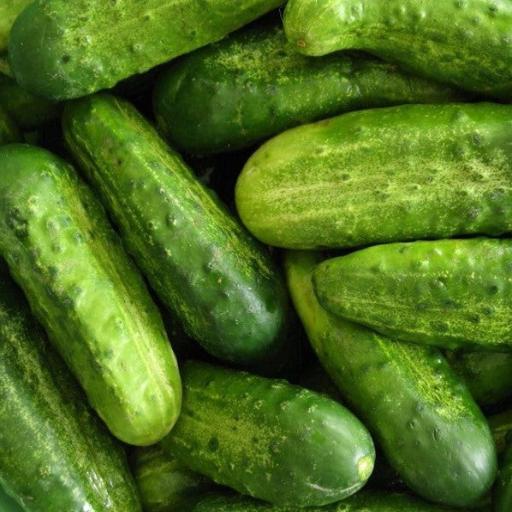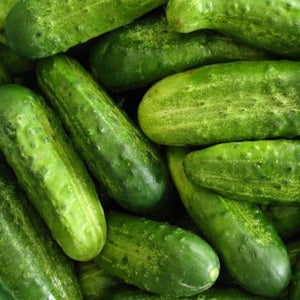- Hardiness Zone: 3-11 Annual
Seed Depth: 1/2 inch
Seed Spacing: 12 inches
Row Spacing: 36–48 inches
Sunlight: Full sun
Days to Sprout: 7–10 days
Days to Maturity: 50–60 days
Growth Habit: Vining
Sunlight: Requires full sun, at least 6–8 hours daily, for robust growth and high yields.
Soil Type: Prefers well-drained, fertile soil with a pH of 6.0–7.0.
When to Plant: Sow seeds directly outdoors after the last frost, when soil temperatures are at least 65°F.
Direct Sowing: Plant seeds 1/2 inch deep, spacing them 12 inches apart. Allow 36–48 inches between rows for vining varieties.
Indoor Sowing: Not recommended; cucumbers perform best when direct-sown.
Succession Planting: Sow every 2–3 weeks for a continuous harvest throughout the growing season.
Watering: Water deeply and consistently, keeping soil evenly moist but not soggy.
Fertilizing: Use a balanced fertilizer at planting and apply compost or potassium-rich fertilizer during fruiting.
Pruning: Prune lightly to improve airflow and reduce disease risk; train vines on trellises if space is limited.
Pest and Disease Control: Monitor for cucumber beetles, aphids, and powdery mildew; treat with organic solutions as needed.
When to Harvest: Pick cucumbers when they are 3–5 inches long for pickling, or slightly larger for fresh use, typically 50–60 days after planting.
How to Harvest: Snip cucumbers from the vine with scissors or pruners to avoid damaging the plant.
Seed Collection: Allow a few cucumbers to fully ripen and yellow on the vine; collect seeds from the mature fruit.
Storing Seeds: Dry seeds thoroughly and store in an airtight container in a cool, dry place.
Why You’ll Love It
National Pickling Cucumbers are a dependable, productive favorite among home gardeners and pickling pros alike. These compact, vigorous plants produce heavy yields of short, straight cucumbers with thin skin, ideal for pickling whole or slicing into spears. The fruits stay crisp even after processing and are just as tasty fresh. Excellent for small gardens, raised beds, and succession planting.
Plant Characteristics
Height: Vine or short trailing habit
Growth Habit: Compact vines with strong productivity
Fruit Type: Blocky, blunt-ended cucumbers, 5–6 inches long
Days to Maturity: 50–60 days
Hardiness: Warm-season annual
Flavor and Culinary Uses
Flavor: Mild, refreshing, and crisp with thin, tender skin
Culinary Uses: Ideal for whole pickles, spears, or fresh eating. Perfect for refrigerator pickles, canning, or adding crunch to salads and sandwiches.
Companion Planting Tips
Good Companions: Beans, radishes, sunflowers, and dill
Avoid Planting Near: Potatoes or aromatic herbs like sage
Bonus Benefit: Attracts pollinators and makes an excellent succession crop for steady harvests
Common Issues and Solutions
Bitterness: Prevent by watering consistently and harvesting while young
Powdery Mildew: Plant in full sun with good airflow; avoid overhead watering
Curved or Misshapen Fruits: Ensure even pollination by attracting bees and avoiding overcrowding
Seeds Per Packet
| 1g | Approximately 36 |
| 2g | Approximately 72 |
| 3g | Approximately 108 |
| 4g | Approximately 144 |
Why You’ll Love It
National Pickling Cucumbers are a dependable, productive favorite among home gardeners and pickling pros alike. These compact, vigorous plants produce heavy yields of short, straight cucumbers with thin skin, ideal for pickling whole or slicing into spears. The fruits stay crisp even after processing and are just as tasty fresh. Excellent for small gardens, raised beds, and succession planting.
Plant Characteristics
Height: Vine or short trailing habit
Growth Habit: Compact vines with strong productivity
Fruit Type: Blocky, blunt-ended cucumbers, 5–6 inches long
Days to Maturity: 50–60 days
Hardiness: Warm-season annual
Flavor and Culinary Uses
Flavor: Mild, refreshing, and crisp with thin, tender skin
Culinary Uses: Ideal for whole pickles, spears, or fresh eating. Perfect for refrigerator pickles, canning, or adding crunch to salads and sandwiches.
Companion Planting Tips
Good Companions: Beans, radishes, sunflowers, and dill
Avoid Planting Near: Potatoes or aromatic herbs like sage
Bonus Benefit: Attracts pollinators and makes an excellent succession crop for steady harvests
Common Issues and Solutions
Bitterness: Prevent by watering consistently and harvesting while young
Powdery Mildew: Plant in full sun with good airflow; avoid overhead watering
Curved or Misshapen Fruits: Ensure even pollination by attracting bees and avoiding overcrowding
Seeds Per Packet
| 1g | Approximately 36 |
| 2g | Approximately 72 |
| 3g | Approximately 108 |
| 4g | Approximately 144 |






Share and get 15% off!
Simply share this product on one of the following social networks and you will unlock 15% off!